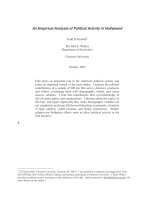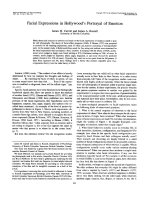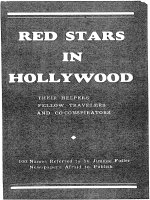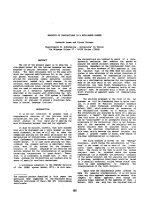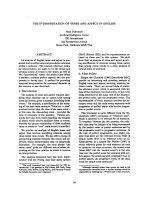SHAKESPEARE IN HOLLYWOOD potx
Bạn đang xem bản rút gọn của tài liệu. Xem và tải ngay bản đầy đủ của tài liệu tại đây (122.47 KB, 14 trang )
SHAKESPEARE
IN
HOLLYWOOD
a new play by
Ken Ludwig
Samuel French Publication Draft – March 25, 2005
Copyright 2005 by Ken Ludwig
Cast of Characters
Oberon
Puck
Jack Warner
Max Reinhardt
Will Hays
Daryl
Olivia Darnell
Lydia Lansing
Louella Parsons
Dick Powell
Jimmy Cagney
Joe E. Brown
The play is written for 12 actors, 4 women and 8 men. The actors playing Hays, Brown, Cagney,
Powell and Daryl double as Albert, Harry, Sam, Groucho, Tarzan and the Cowboy. If extra
actors are available, they can play movie stars at the opening of the play, cameramen,
seamstresses, etc.
SHAKESPEARE IN HOLLYWOOD premiered on September 5 , 2004 at Arena Stage in
Washington, D.C., Molly Smith, Artistic Director, Stephen Richard, Executive Director, Guy
Bergquist, Producer. It was directed by Kyle Donnelly. The set was designed by Thomas
Lynch, the costumes were by Jess Goldstein, the lighting by Nancy Schertler, and the sound by
Susan R. White. The Company Manager was Jill A. Mauritz, the Casting Director was Eli
Dawson, and the Choreographer was Karma Camp. The Stage Manager was Brady Ellen Poole,
the Assistant Stage Manager was Amy K. Bennett, the Fight Choreographer was Brad Waller,
the Dramaturg was Michael Kinghorn, the Speech and Vocal Consultant was Lynn Watson, and
the Technical Director was Jim Glendinning. The production was graciously sponsored by Esthy
and Jim Adler.
The cast, in order of appearance was as follows:
Louella Parsons Ellen Karas
Max Reinhart Robert Prosky
Dick Powell David Fendig
Jack Warner Rick Foucheux
Daryl Michael Skinner
Lydia Lansing Alice Ripley
Oberon Casey Biggs
Puck Emily Donahoe
Olivia Darnell Maggie Lacey
Will Hayes Everett Quinton
Joe E. Brown Hugh Nees
Jimmy Cagney Adam Richman
Ensemble Bethany Caputo
Scott Graham
Eric Jorgensen
Robert McClure
For Mom and Dad, always.
Ken
SHAKESPEARE IN HOLLYWOOD
by Simon Reade
for Arena Stage Production Journal
The name rang a bell. “He’s called Ken Ludwig, Simon,” said Adrian Noble, then Artistic
Director of the Royal Shakespeare Company. “He’s in Stratford. Big supporter of the RSC in the
States. He’s got some ideas he wants to run past us.” Ken Ludwig? Surely not Lend-Me-A-
Tenor-Crazy-For-You Ken Ludwig? What on earth would that master of American screwball
comedy want with a classical, Shakespeare ensemble? As Literary Manager at the RSC at the
time I was a champion of poetic theatre, pursuing commissions that tended towards political
epics. The imp in me surmised that the RSC could well do with upsetting its own applecart; but it
is a state subsidised theatre. This Ken Ludwig is the darling of commercial theatre.
Curious, I met the guy.
Well, never judge a writer entirely by his output. Just as Dostoevsky probably wasn’t all doom
and gloom, wisecracking Ken Ludwig’s got his serious points too. Sure, he’s fun, full-of-beans.
But he’s also exceptionally well-read, bright as a button, with an enthusiasm for comedy and
music theatre across the centuries. He’s an expert who kept – who keeps putting me to shame in
my lack of appreciation of the popular stage, of the movies. And I don’t just mean the cheesy
matinees we’d snigger and sneer at today. He can extemporise on the clown in European
Renaissance drama, on the wit of the 18
th
century playwrights, on the inter-War stars of the
Silver Screen… On our first meeting, in the sunshine of Stratford-upon-Avon, he charmed me,
he delighted me. And, canny fellow he is, he’d pitch several ideas at me before I’d even realised
he’s started.
Some had been long in gestation: a rewrite of a Regency Tony Lumpkin sequel to She Stoops to
Conquer. We read the original and realised why it necessitated a rewrite. It was trash. We
decided not to go there. Some ideas had been dreamt up on the hoof: inspired by walking
backstage, along the narrow passage where the huge 1930s Royal Shakespeare Theatre collides
with the Elizbethan-style Swan Theatre, Ken had seen the actors from contrasting shows co-
mingle, mid-performance. What if, in this collision, the modern dress performers get confused
with the doublet-and-hosed, take a wrong turning and end up on the wrong stage in the wrong
play, mused Ken. We laughed and laughed as he improvised and then had the good grace to
admit Michael Frayn had written Noises Off, Alan Ayckbourn House and Garden. Ken’s is still
an even wilder idea, but we didn’t pursue this either.
We also talked about the whole Shakespeare industry and how the recent movies – from Ken
Branagh, via Baz Luhrman, to Shakespeare in Love - had introduced the plays and the man to a
whole new generation who’d rejected the works in the classroom or in the lyric theatre.
Shakespeare in Love in particular inspired us. Marc Norman and Tom Stoppard’s marvellous
screenplay had illustrated how the Elizabethan Theatre of ruthless producers and jobbing script
writers, wasn’t a million miles away from the Hollywood studio system.
It was then that Ken mentioned something in passing and we both had that ‘ping’, light-bulb
moment. A film I should have known about, but didn’t – Max Reinhardt’s 1936 movie of A
Midsummer Night’s Dream – was even more amazing in its making than the finished product
itself. It was a story which got right to the heart of the commercialisation of art, the opportunism
of Hollywood, the use and abuse of the most venerated writer of all time, Shakespeare. It charted
the creative quirks of a meister of mittel Europische Kinema, Max Reinhadt. And it had a cast of
starlets: Mickey Rooney, Jimmy Cagney. And the more he talked, the more animated he became.
Ken explained to me about Will Hays, the daffy self-appointed censor, whose application of the
Hays Code to the sexiness and magical realism of Shakespeare’s dream play was an outrage –
very funny, but an outrage nonetheless. And there it was, the embryo of a play which embraced
the Shakespeare industry, Hollywood exploitation, US cultural imperialism, the clash of
ideologies (liberal and philistine, European and American), of dreams versus nightmares with
fascism in Germany a distant but significant rumble. I saw a serious play in the making. I guess
Ken had the genius to see that its seriousness could be conveyed through an accumulation of
farcical mayhem.
Key to that, and what I learnt from Ken as we developed it first with the RSC (who didn’t
produce it, internal political changes getting in the way) and most recently in a try-out reading at
Bristol Old Vic where I am now joint Artistic Director, is this brilliant genre which I believe is
peculiar to the American psyche: high-jinx, screwball comedy. British people would never be
that zany. We’re too knowingly cynical. Funny, yes. But don’t we just know it. It is a genre
specific to the American stage and screen of the mid 20
th
century. And Ken is the modern master
of it, his passion for its vaudevillian high-octane antics fuelling his messianic zeal to recapture its
essence for contemporary audiences.
Ken’s passion for Shakespeare (his family, even his personal email address all seem to be named
after one Shakespeare character or another) is also evident in his new play. Shakespeare in
Hollywood is thus a deeply personal play as much as a popular play. And in the spirit with which
I used to commission plays at the RSC it’s also poetic and political and, let’s not be afraid to say
it, something of a mini-epic. Yet it’s also got a screw loose, the playwright’s having a ball.
Screwball. Good comedy. Good drama. Good fun.
Simon Reade is joint Artistic Director of Bristol Old Vic where he has adapted Jill Tomlinson’s
The Owl Who Was Afraid of the Dark. He has worked extensively in film and television, for the
BBC and Tiger Aspect in particular. He was Literary Manager and Dramaturg at the RSC 1997-
2001 where his adaptations included Salman Rushdie’s Midnight’s Children and Ted Hughes’
Tales from Ovid. He was Literary Manager at London’s Gate Theatre in the early 1990s.
Foreword
In the 1930s, the talkies discovered Shakespeare in a big way. Four significant
movies based on Shakespeare plays were made within a span of four years: “The Taming
of the Shrew” starring Douglas Fairbanks and Mary Pickford; “As You Like It” starring
Laurence Olivier and Elizabeth Bergner; “Romeo and Juliet” starring Leslie Howard and
Norma Shearer; and, the subject of this play, “A Midsummer Night’s Dream” directed by
Max Reinhardt.
The film studios in the 1930s recognized quickly that movies based on
Shakespeare plays were “box office poison.” However, in doing research for this play, it
soon became clear to me that the Shakespeare films of that time were often made because
the mistresses or wives of the studio heads wanted to be in such “prestigious” movies to
enhance their reputations. Elizabeth Bergner, who starred in “As You Like It” was
married to Robert Czinner, the director of the film. Irving Thalberg, production chief of
MGM put Norma Shearer into “Romeo and Juliet” despite her age. And for Fairbanks
and Pickford, who were married, “The Taming of the Shrew” was a family affair as well.
(This is the movie that caused great hilarity in its opening minute by announcing that the
play was “by William Shakespeare with additional dialogue by Sam Taylor.”)
In writing Shakespeare in Hollywood, I’ve tried to stick to the historical record as
much as possible. Thus, Max Reinhardt, the most famous stage director of his
generation, did come to Hollywood from Austria as a refugee from the Nazis, and he
directed his first (and only) motion picture, “A Midsummer Night’s Dream” for Warner
Brothers Pictures in 1934. Jack Warner did have three brothers, Harry, Albert and Sam,
who ran the studio with him. Their father did start out as a shoemaker. And Louella
Parsons, the most famous gossip columnist of her day, was born Louella Oettinger in
Dixon, Illinois.
Dick Powell, who played Lysander in the movie, was indeed a heartthrob of the
1930s, and he starred in a string of successful musicals, including “42
nd
Street.” James
Cagney, the biggest star of the movie, did play Bottom, though he was best known at the
time for gangster pictures. The emerging child star, Mickey Rooney, ultimately played
Puck in the movie; however, his filming was indeed delayed by the accident he had while
skiing with his mother. Also, as Olivia mentions in the course of the play, for the 250
years prior to 1900, Puck was often played by a woman.
The terms of the Production Code that Hays outlines in the play are virtually
verbatim from the actual Production Code that caused untold misery for every studio in
Hollywood. Moreover, the objections that Hays raises in the play are the ones that the
Hays Office actually raised at the time of filming. (Jack Warner himself wanted
Reinhardt to cut the “love scene” in “Pyramus and Thisbe” because both characters were
played by men and he was afraid that the Hays Office was going to object.) The biggest
objection of the Hays Office was to the black fairy overcoming the white fairy towards
the end of the movie. Reinhardt said that he created the black fairy to represent the evils
of Nazism. Ultimately, this and the other objections were withdrawn. No one knows
exactly why.
It is also true that Joe E. Brown, who played Flute, had just finished filming the
third of three baseball movies based on the short stories of Ring Lardner. Jimmy
Cagney’s movie previous to the “Dream” was a Western, “The Frisco Kid.”
To me, one of the most surprising aspects of Shakespeare in the movies is that
dozens of silent pictures were made from Shakespeare’s plays before the advent of sound.
Obviously, the producers in those days thought that Shakespeare’s stories alone were
strong enough to carry the films. Many of these silent movies can be seen on a DVD
entitled Silent Shakespeare, released by Milestone Film & Video (2000)
I wrote Shakespeare in Hollywood on commission from The Royal Shakespeare
Company in England, and I may have enjoyed writing this play more than any other I’ve
ever written. An academic at heart, I loved the research; to me, Hollywood in the 1930s
is the bee’s knees; and as a Shakespeare addict to end all addicts, I loved living for a few
months with Oberon and Puck. So my thanks to Simon Reade, Literary Manager of the
RSC (now Artistic Director of the Bristol Old Vic), whose faith in the play has been
unwavering, and to Adrian Noble, Artistic Director at the RSC at the time of the
commission. Equal thanks to Molly Smith and Arena Stage for mounting the premiere
and helping me select such a clever director, Kyle Donnelly, and such an inspired cast.
Ken Ludwig
Washington, D.C.
March 29, 2005
What is love? ’Tis not hereafter,
Present mirth hath present laughter;
What’s to come is still unsure:
In delay there lies no plenty;
Then come kiss me, sweet and twenty;
Youth’s a stuff will not endure.
TWELFTH NIGHT
Act Two, Scene Three
March 25, 2005 Final Publication Draft 1
Act One
HOLLYWOOD, 1934. An orchestra is playing
“Hooray for Hollywood,” and lights are criss-
crossing the sky like enormous, reckless fireflies.
We feel the excitement and glamour of movie-land
at its height.
We’re at the world premiere of a new movie in front
of Grauman’s Chinese Theater. LOUELLA
PARSONS, the iconic gossip columnist for the
Hearst newspapers and well-known radio
personality, is at a microphone, broadcasting live,
and a rope barrier separates her from hundreds of
screaming fans who have shown up to see their
favorite movie stars. Some of these stars,
glamorous and trendy, wave to the crowd as they
parade into the theatre past Louella.
LOUELLA
Good evening, good evening to all of you out there in radio-land, this is Louella Parsons,
your eyes and ears in Hollywood, at the sensational premiere of the new motion picture
“A Midsummer Night’s Dream,” by the Warner Brothers. That’s right, we have a night
of culture ahead of us, a movie by the Swan of Avon himself, Mr. William Shakespeare,
and if he could only see the excitement here tonight, he would be swimming down that
river just as proud as a peacock. And don’t let that word “culture” frighten you, my
darlings, because the word on this movie is sock-o entertainment from start to finish.
And what else would you expect from a talking picture starring Mr. Dick Powell!
(screams from the crowd)
Miss Anita Louise!
(more screams)
And Mr. James Cagney!!
(even bigger screams – as CAGNEY goes by and waves to the crowd)
Wait a moment. A limousine is pulling up. Someone is getting out … Oh my darlings,
how exciting, it’s the director of the movie himself, Mr. Max Reinhardt!
(A disappointed “Ohhhh …” from the crowd as MAX
REINHARDT enters. He’s a pixie-ish man in his 60s and he has a
pronounced German accent.)
LOUELLA
Max! Over here! … He’s coming this way … Ah, Professor Reinhardt, it’s Louella
Parsons. Welcome to the opening of your new cinematic sensation.
REINHARDT
Thank you, Louella, I’m –
March 25, 2005 Final Publication Draft 2
LOUELLA
(to the radio audience)
I’m sure you all know that Professor Reinhardt is considered the most distinguished
director working today in the live theatre. Now tell us, Max, did it scare you a little,
directing your first motion picture ever?
REINHARDT
No, not really. But I –
LOUELLA
“No, not really.”
(laughing)
Oh, Max, you’re priceless. Now do I hear an accent in your speech? Are you from
abroad?
REINHARDT
Ja, I am from Austria. And I have –
LOUELLA
“From Austria.” How adorable. And what brings you to the United States?
REINHARDT
Heh heh, this is going to make you laugh, is funny story. There is man in my country
named Hitler who is killing people.
LOUELLA
Oh yes of course. And we’re just thrilled that you got away. Wait! A limousine has just
pulled up … Oh, it is! It’s Dick Powell!
(Screams – and DICK POWELL enters. He’s a good-looking,
boyish actor in his late 20s. He waves to the crowd and sings:)
POWELL
“I’m young and healthy, and you’ve got chaaaaarm!”
(Bigger screams.)
LOUELLA
Dick! Dick! It’s Louella!
(Louella chases after Powell, leaving Reinhardt stranded. He turns
and speaks to the audience.)
March 25, 2005 Final Publication Draft 3
REINHARDT
And for this I have left my homeland. True, alternative is the Nazis, but is very close
race. So: vhy am I here, you ask? It all began one year ago vhen I found myself for very
first time in this legendary place called Hollyvood: land of glamour and gluttony, palm
trees and poodles, sequvins and sin. At this time, I have just put on big stage production
of Shakespeare’s masterpiece “A Midsummer Night’s Dream,” and I get raves and kudos
you vould not believe. So, I ask myself, vhy not make a film of this production using big
hot-shot Hollyvood stars. It vould be a great contribution to world culture, a real treat for
lovers of Shakespeare, and, between you and me, I could make a few bucks in the
process. With this in mind, exactly one year ago today, I go to see Jack Warner of
Warner Brothers Pictures.
(The scene shifts to Jack Warner’s office at the Warner Brothers
Studio. JACK WARNER is behind his desk. He’s a natty dresser
and tough as nails. Sitting nearby is DARYL, who’s known in the
trade as a “yes-man.” He’s 25 to 30 and wears glasses. As the set
is changing, Reinhardt continues:)
REINHARDT
Mr. Warner, I say to him, you are great producer and famous man. But you have not yet
achieved the respect you deserve as man of innovation and artistic vision. So what do
you say about making movie of Shakespeare’s play “A Midsummer Night’s Dream.”
WARNER
You’re an idiot!
REINHARDT
Okay, but what do you say?
WARNER
Listen, Mel – can I call you Mel?
REINHARDT
Sure, but my name is Max.
WARNER
Right, Max, now I’ve been asking around about you, and people tell me that you’re really
smart.
REINHARDT
Is true, I am genius.
WARNER
Good. Then you’ll understand this perfectly. It’s a dumb idea. Am I right, Daryl?
March 25, 2005 Final Publication Draft 4
DARYL
Yes sir!
WARNER
Now why do you think we make movies, Max? Take a wild guess.
REINHARDT
To make artistic contribution to world culture?
WARNER
Wrong. We make movies to make money. They even have the same first letter. Movies.
Money.
REINHARDT
Ah, but what if you use that money to make “Midsummer Night’s Dream.” Is another M.
WARNER
And so is moron! It ain’t gonna happen!
REINHARDT
But you could make it happen!
WARNER
You’re an idiot!
REINHARDT
Okay, fine! I take project back to Adolph Zukor at Paramount, he is begging me for this
picture!
WARNER
You’re a liar!
REINHARDT
(to the audience)
And he’s right, of course, I am lying through my head. But at this moment, a miracle
occurs. A fairy princess, like in Shakespeare play, comes through that door and changes
everything.
LYDIA
(striding into the room)
I’m a slut!
(LYDIA LANSING is a beautiful blond starlet with a whiny,
show-girl voice. She sleeps with Jack Warner, not just to get
ahead, but also because she likes him. She’s just come off the set
of an historical action picture and she’s wearing a cheap, bright red
March 25, 2005 Final Publication Draft 5
costume, torn and shredded along the skirt to show she’s been in a
battle, and across the chest to show that she has a lot of cleavage.
Somewhere deep inside that cleavage is a nice kid. She carries a
fan magazine and she’s fuming.)
WARNER
Lydia!
LYDIA
That’s what they call me, Jack! A slut! Look at this! “Photoplay Magazine.” “The Ten
Biggest Sluts in Hollywood.” And who do ya think is number one? The Queen of the
Sluts? Take a guess.
WARNER
You?
LYDIA
Bingo! You got it, Jack. And do you know why it’s me? Huh? Do ya?! ’Cause I do all
the stinkin’ pictures you give me!
WARNER
But darling –
LYDIA
“Gun Moll Mama.” Remember that one? And “Hold My Pistol.”
WARNER
But they made you a star!
LYDIA
A star? You call this a star?!
(her costume)
Look at me! I’m in a fucking French Foreign Legion picture! “Oh Major Waverly, I feel
so frightened by those nasty heathens surrounding Fort Chutney.”
(she wiggles – her trademark wiggle)
“How will I ever get back to my ancestral home in Dundee, Scotland?”
WARNER
But sweetie-pie -
LYDIA
Don’t touch me! Now I want somethin’ decent for a change. Somethin’ with prestige.
You’re makin’ biography pictures, give me one of those. I’d be great in a biopic. I could
play Madame Curie. Listen to this, I wrote it myself: “Oh, Dr. Mendel, just look at them
squiggly things under the microscope. I think they could cure somethin’! Somethin’ bad,
like disease! Wait! We’ll call it … penicillin!”
